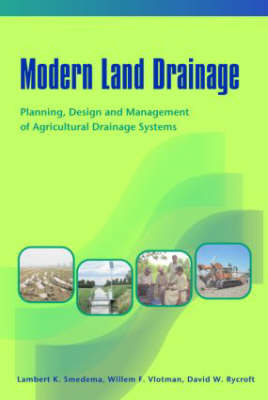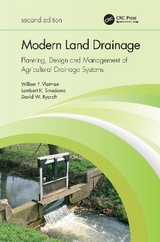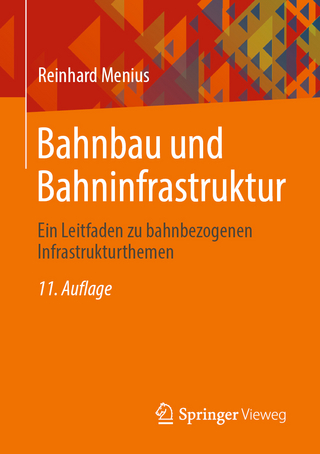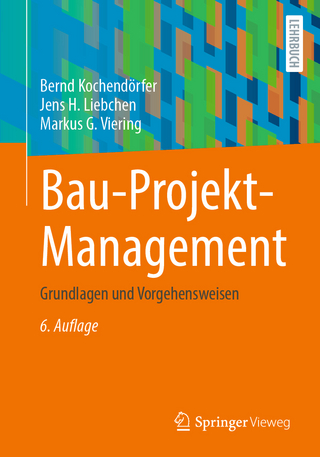
Modern Land Drainage
A A Balkema Publishers (Verlag)
978-90-5809-554-1 (ISBN)
- Titel erscheint in neuer Auflage
- Artikel merken
Fully renewed and extended, this edition is a valuable source of information for anyone involved in drainage engineering and management. It provides new theories, technologies, knowledge and experiences in combination with traditional land development practices in the humid temperature zone. Aspects covered include: management and maintenance; drainage application and design; and adverse impacts on the environment. Intended as both a handbook and a textbook, this work is of particular value to university students as well as professionals within drainage development, engineering and management.
LAMBERT K SMEDEMA worked for most of his career for Euroconsult on irrigation in Africa and South America and on drainage in the Middle East and Asia. He was a lecturer/researcher at the University of Nairobi and at the Delft University of Technology. During the nineties, he worked as a consultant with the World Bank and with the Food and Agriculture Organization of the United Nations. Lambert Smedema is currently working as an independent consultant. WILLEM F VLOTMAN has worked both with consultants and research organisations throughout his professional career. Since November 2004, he has been working for Sinclair Knight Merz (SKM) consultants, in Tatura, Australia as Senior Irrigation and Drainage Specialist. Dr. Vlotman has worked widely internationally and written numerous publications. He is chairman of the Working Group on Drainage of the International Commission on Irrigation and Drainage (ICID). DAVID W RYCROFT began his professional career working for the UK Ministry of Agriculture at their Field Drainage Experimental Unit based in Cambridge. He subsequently joined consultants Sir M MacDonald and Partners and worked as a salinity control and land drainage specialist on large irrigation projects in Iraq, Somalia and Egypt. In 1979, David Rycroft joined the Institute of Irrigation Studies (Southampton University) to teach in combination with his overseas consultancy work.
Table of Contents
PART I INTRODUCTION .....................................................................................1
1 LAND DRAINAGE FOR AGRICULTURE ............................................1
1.1 Drainage Objectives; Scope of the Book ...................................................3
1.2 Waterlogging Control ................................................................................5
1.3 Agro Hydrological Regimes ....................................................................10
1.4 Drainage Systems.....................................................................................13
1.5 Bio-drainage.............................................................................................14
1.6 Environmental Impacts ............................................................................15
1.7 Global Drainage Zones ............................................................................22
1.8 Drainage Development Considerations ...................................................25
2 PLANNING AND DESIGN....................................................................29
2.1 Field Investigations ..................................................................................29
2.2 Stages of Project Preparation ...................................................................30
2.3 Basic Design Criteria ...............................................................................31
2.4 Design Rainfall ........................................................................................34
2.5 Design of Field Drainage Systems...........................................................37
2.6 Determination of Design Criteria.............................................................38
3 WATER IN THE SOIL ...........................................................................41
3.1 Forms and Nature of Occurrence of Water in the Soil.............................41
3.2 Pressures in the Soil Water ......................................................................42
3.3 Soil Moisture Characteristics ...................................................................44
3.4 Soil Water Potential and Soil Water Movement ......................................46
3.5 Hydraulic Conductivity............................................................................48
3.6 Unsaturated Zone; Soil Moisture Constants ............................................49
3.7 Infiltration and Percolation ......................................................................52
3.8 Groundwater Flow; Laplace Equation .....................................................54
PART II SYSTEMS AND TECHNOLOGY .........................................................57
4 SUBSURFACE DRAINAGE SYSTEMS...............................................59
4.1 Pipe Drain Systems ..................................................................................60
4.2 Deep Ditch Systems.................................................................................63
4.3 Drain Pipes...............................................................................................64
4.4 Envelopes.................................................................................................69
4.5 Envelope Design Guidelines and Criteria................................................75
4.6 Structures in Pipe Drain Systems.............................................................83
4.7 Construction of Pipe Drain Systems ........................................................88
5 SURFACE/SHALLOW DRAINAGE SYSTEMS................................103
5.1 Bedding Systems....................................................................................104
5.2 Shallow Ditch Systems ..........................................................................106
5.3 Mole Drainage Systems .........................................................................113
5.4 Pipe Drainage Systems...........................................................................115
5.5 Complementary Measures......................................................................118
6 MAIN DRAINAGE SYSTEMS............................................................121
6.1 Main Features.........................................................................................121
6.2 Low Land and Upland Drainage............................................................128
PART III PLANNING AND DESIGN..................................................................135
7 DESIGN OF PIPE DRAINAGE SYSTEMS.........................................137
7.1 Flow Patterns..........................................................................................137
7.2 Drain Spacing Formulae ........................................................................140
7.3 Hooghoudt Formula ...............................................................................142
7.4 Non-Steady State Drainage Formulae....................................................146
7.5 Basic Design Criteria .............................................................................153
7.6 Drain Depth............................................................................................160
7.7 Pipe Diameter.........................................................................................162
8 DESIGN DISCHARGES.......................................................................169
8.1 Discharge Transformation......................................................................169
8.2 Approaches ............................................................................................172
8.3 Statistical Analysis of Observed Discharges .........................................174
8.4 Flat basins ..............................................................................................175
8.5 Sloping Basins........................................................................................181
8.6 Area Reduction Formulae ......................................................................189
8.7 Discharge Reduction through Storage ...................................................191
9 HYDRAULIC DESIGN OF DRAINAGE CANALS AND STRUCTURES ............................................................................201
9.1 Drainage Canals .....................................................................................201
9.2 Structures in Drainage Canals................................................................210
9.3 Tidal Outlets...........................................................................................216
9.4 Pumps.....................................................................................................220
PART IV SALINITY CONTROL .........................................................................229
10 SOIL SALINITY ...................................................................................231
10.1 Forms of Occurrence and Distribution of Salts in the Soil ....................232
10.2 Agricultural Impacts; Diagnosis and Assessment..................................237
10.3 Classification..........................................................................................245
10.4 Conventional Mapping and Sampling....................................................248
10.5 New Salinity Measurement and Mapping Techniques ..........................252
11 IRRIGATION INDUCED SALINISATION ........................................257
11.1 Salinisation by the Applied Irrigation Water .........................................257
11.2 Salinisation from the Groundwater (Capillary Salinisation)..................257
11.3 Sodification ............................................................................................260
11.4 Salt Balance of Irrigated Land ...............................................................261
11.5 Irrigation Water Quality.........................................................................266
12 DRAINAGE OF IRRIGATED LAND..................................................273
12.1 Waterlogging and Salinity .....................................................................273
12.2 Surface Drainage....................................................................................274
12.3 Pipe Drainage Systems...........................................................................276
12.4 Well or Vertical Drainage ......................................................................285
12.5 Main Drainage........................................................................................288
PART V SPECIAL TOPICS.................................................................................293
13 SEEPAGE AND INTERCEPTION.......................................................295
13.1 Drainage Systems for Sloping Land ......................................................295
13.2 Interception ............................................................................................298
13.3 Natural Drainage of River Valleys.........................................................301
13.4 Seepage into a Polder.............................................................................302
13.5 Seep Zones and Springs .........................................................................305
14 RECLAMATION AND DRAINAGE OF UNRIPENED SOILS.........307
14.1 The Soil Ripening Processes..................................................................307
14.2 Reclamation and Drainage Methods ......................................................309
14.3 Acid Sulphate Soils................................................................................311
14.4 Subsidence Prediction ............................................................................314
15 DRAINAGE OF RICE LANDS............................................................319
15.1 Surface Drainage....................................................................................320
15.2 Subsurface Drainage ..............................................................................324
15.3 Crop Diversification...............................................................................325
15.4 Flood Control .........................................................................................326
16 CONTROLLED DRAINAGE...............................................................329
16.1 Current Issues and Developments..........................................................329
16.2 Design Considerations ...........................................................................330
16.3 Operation and Maintenance by Farmers ................................................338
16.4 Controlled Drainage at the Regional Level............................................341
17 COMPUTER APPLICATIONS ............................................................345
17.1 Drainage Design Applications ...............................................................345
17.2 Rainfall Discharge Models.....................................................................348
17.3 Ground Water Flow Models ..................................................................351
17.4 Agrohydrological Models ......................................................................352
17.5 Salinity Prediction Models.....................................................................356
PART VI FIELD INVESTIGATIONS AND COST EVALUATION..................359
18 FIELD SURVEYS AND INVESTIGATIONS.....................................361
18.1 Climate ...................................................................................................361
18.2 Topography............................................................................................364
18.3 Soil and Land Conditions.......................................................................365
18.4 Soil Parameters and Properties...............................................................367
18.5 Watertable and Groundwater .................................................................371
18.6 Hydrology and Geohydrology ...............................................................374
18.7 Agriculture and Irrigation ......................................................................375
18.8 Pilot Areas and other Field Tests ...........................................................376
18.9 Environment...........................................................................................377
18.10 Miscellaneous Investigations .................................................................379
19 HYDRAULIC CONDUCTIVITY.........................................................381
19.1 Laboratory Measurement .......................................................................381
19.2 Field Measurements below the Watertable ............................................382
19.3 Field Measurements above the Watertable ............................................390
19.4 Composed K-Values ..............................................................................392
19.5 Surveys and Data Processing .................................................................394
20 COST EVALUATION ..........................................................................399
20.1 Required Information.............................................................................399
20.2 Discounting ............................................................................................400
20.3 Evaluation Indices..................................................................................401
20.4 Examples of Cost Evaluation of Drainage Projects ...............................402
20.5 Cost Calculations for Pipe Drainage Systems........................................403
PART VII MANAGEMENT...................................................................................407
21 INSTITUTIONAL, ORGANISATIONAL AND FINANCIAL ARRANGEMENTS..............................................................................409
21.1 Drainage Laws .......................................................................................409
21.2 Development and Management Models.................................................409
21.3 Public Drainage Organisation ................................................................412
21.4 Financing................................................................................................414
22 MAINTENANCE..................................................................................419
22.1 Classification..........................................................................................419
22.2 Organisation, Planning and Execution...................................................419
22.3 Maintenance of Open Canals .................................................................420
22.4 Maintenance of Pipe Drains...................................................................426
22.5 Developing Countries ............................................................................430
23 PERFORMANCE ASSESSMENT AND BENCHMARKING............433
23.1 Drainage Design and Performance ........................................................433
23.2 Indicators................................................................................................434
23.3 Performance Assessment Procedure ......................................................434
23.4 Performance Checking of Pipe Systems ................................................437
23.5 Causes of Under-Performance of Drainage Systems.............................438
INDEX .......................................................................................................................441
ABOUT THE AUTHORS ....................................................................................... 447
| Erscheint lt. Verlag | 15.8.2004 |
|---|---|
| Verlagsort | Rotterdam |
| Sprache | englisch |
| Maße | 174 x 246 mm |
| Gewicht | 1010 g |
| Themenwelt | Technik ► Bauwesen |
| ISBN-10 | 90-5809-554-1 / 9058095541 |
| ISBN-13 | 978-90-5809-554-1 / 9789058095541 |
| Zustand | Neuware |
| Informationen gemäß Produktsicherheitsverordnung (GPSR) | |
| Haben Sie eine Frage zum Produkt? |
aus dem Bereich



